It seems rather fitting that my first post and last post in this weblog are about the Truth and Reconciliation Commission. I began this course with no knowledge of the Truth and Reconciliation Commission; however, as I have researched my chosen topic, residential schools, I have come to learn quite a lot about the Truth and Reconciliation.
Upon learning about the Commission I was impressed and proud of the Canadian Government’s efforts to seek information of the horrors children endured at residential schools with an aim towards reconciliation with Indigenous peoples. This seemed to me to be very positive and progressive.
I am disappointed to learn this week that the Commission is, in all likelihood, expected to be given an extension of one year. This extension seems to be needed as the government has been withholding valuable documents regarding the horrid abuses committed at St. Anne’s Indian Residential School in Fort Albany, Ontario and other key documents.
I am hopeful that the Commission can continue it’s invaluable work, and that the Canadian Government can renew it’s commitment to truth and reconciliation.


